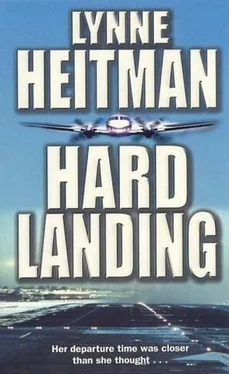"That's not our job."
He turned away in frustration, then circled back and motioned to the TV screen. "Aren't you even curious about how they did this? That pisshead Dwyer kid took that Beechcraft down and is still out working the ramp loading airplanes. He's working tomorrow. What if, God forbid, something happened and we knew about this and didn't do anything?"
"We can take him out of service. Or assign him to the stock room."
"Boss, I don't want this guy anywhere near one of my airplanes."
Having seen what I'd just seen, it was hard to argue with that sentiment. With both palms flat on the surface, he leaned across the table. "Shanahan," he said, looking me directly in the eye, "I need to finish this tonight."
His tie had disappeared long ago, his shirttail was out, and I noticed for the first time how thin he'd become, too thin for his suit pants. His face was drawn, his forehead lined with every sleepless night he'd spent thinking about why Ellen had died and, more painful than that, what his role in her death might have been. I had a feeling that watching that videotape had taken more out of him than he could have admitted, and it occurred to me that he might have been leaning on that table because he was too worn out to stand up. No matter what I had promised Bill, there was no way Dan was going home tonight. With the answer right there in front of us on the table, he didn't have enough left to wait it out until tomorrow. It had to be finished tonight.
I checked my watch. Tom Gutekunst from Corporate Security would be in at six o'clock in the morning. We had almost eight hours. I reached out for a stack of papers.
"Sit down before you fall down," I said, handing him half, "and start with these."
Every once in a while I'd look up to see Dan's lips moving as he read through the papers in his lap.
I was still plowing through the first document I'd picked up. It was officially known as the National Transportation Safety Board Aircraft Accident Report for Nor'easter Airlines, Inc., Flight 1704, Beech Aircraft Corporation 1900C, Baltimore, Maryland, March 15, 1995. It looked like aircraft accident reports look- standard formats, factual, statistical-and I was having a hard time with it. I had just seen the people who had boarded that flight, human beings that were here reduced to tables and charts and codes. The loss of their lives and the loss of equipment were treated not dissimilarly with everything measured, weighed, counted, and set down on a page in black-and-white.
I flipped back to the beginning and started again, reading the same words I'd read twice already, looking for the highlights this time and trying to retain at least some of the information.
On March 15, 1995, a Beech 1900C which was operating as NOR 1704 crashed on final approach to Baltimore. Seventeen passengers, the captain, and the first officer were all killed. The dog being transported in the kennel in the aft cargo compartment had survived.
In the section marked personnel information, I found out that the captain had been forty-one years old. He'd flown with Nor'easter for seven years and worked as an instructor/check pilot for this type of aircraft. Fellow crew members described him as "diligent, well trained, and precise." The first officer was thirty-six. His position with Nor'easter was his first regional airline job, but he'd been flying for eight years. It was an experienced crew.
A few pages over and a couple of paragraphs down was the section marked history of the flight. On the day of the accident, the captain arrived at the airport in Baltimore at 1300 for a 1400 check-in. No one who saw him that afternoon reported anything unusual about his behavior. That day he and his first officer flew a round trip from Baltimore to Syracuse with a scheduled stopover in Boston each way. They flew two more round trips between Baltimore and Boston that afternoon and evening. Flight 1704 was the last scheduled for the day. They'd never made it home.
On that final leg, the flight was delayed in Boston due to bad weather, and didn't take off until 2015, ninety minutes after the scheduled departure time. Weather at the time of departure was heavy rain, low clouds, and poor visibility.
At 2149, the Baltimore tower cleared NOR 1704 to descend to and maintain 6,000 feet.
At 2156, NOR 1704 contacted the tower and requested the current Baltimore weather. It was thirty-seven degrees, low broken clouds, winds out of the northwest at ten knots.
At 2157, NOR 1704 was cleared for landing.
Ground witnesses who saw the aircraft on the short final approach to the runway said its wings began to rock back and forth. The aircraft went nose up, then into a steep bank and roll. The right wing contacted the ground first. Its forward momentum caused it to cartwheel, breaking into pieces and scattering wreckage over a quarter mile. The accident occurred during the hours of darkness. Part but not all of the fuselage burned. The aircraft was destroyed. No survivors.
I stared at the page until I thought I heard Dan say something, but when I looked up, he was still sitting exactly as I'd seen him before, with his feet on the table, one hand on the reports and the other on the armrest propping his head up. Behind him on the TV screen, the tape was still running. I found the remote control and turned it off.
"What's the matter?" he asked.
"Nothing." If I'd not said anything at all, I'm not sure he would have noticed. He was talking to me, but completely absorbed in what he was reading.
One of the appendices in my report was a map of the wreckage, a computer-generated diagram that showed the major pieces, of which there were many, and where they had landed relative to each other and the airport. I turned to the back and looked at it again, studying it more closely this time. I was trying to remember what this crash had looked like. I was searching for the image, that signature shot that is so visceral, so horrible, or so poignant that it gets burned into our collective consciousness and becomes shorthand for this and only this tragedy. Workers in hip waders and diving gear slogging through swamps with gas masks and long poles. A flotilla of boats out on gray seas with grim-faced men dragging parts of people and machinery out of the water. Scorched mountaintops and flaming oceans and fields of snow fouled by oil and soot. Tail sections with logos intact, absurdly colorful amid the twisted, blackened ruins. I tried to remember 1704, but when I closed my eyes, all I could see was that patch of empty concrete. It was so quiet in the room I could almost hear the rain.
"Holy shit, boss." Dan's feet dropped to the floor, jarring me back to the present. "Holy shit."
His raised eyebrows and excited smile told me he'd hit pay dirt. "Tell me."
"You're not going to believe what this is. You've got the official version there of what happened that night"-he nodded to my report-"but I've got the real story." He held up a ratty pile of dog-eared, handwritten pages he'd been reading. It was stapled in the corner, but just barely. "This is Dickie Flynn's confession."
"Confession?" The word alone, freighted with all that Catholic significance, brought a shudder of anticipation. What sins were we about to hear?
"Everything that happened that night in order- bing, bing, bing. And see that? Dickie wrote it himself and signed it." He turned to the last page and held it up just long enough for me to see the scrawled signature of one Richard Walter Flynn. "According to this, Dickie was here that night and right in the middle of everything."
I set my report to the side. "How did they do it?"
"I'll show you. What did the investigators say was the official cause?"
"Pilot error. They say the pilot miscalculated the center of gravity, that it could have been as much as eleven inches aft of the aft limit, which significantly screwed up the weight and balance."
Читать дальше












